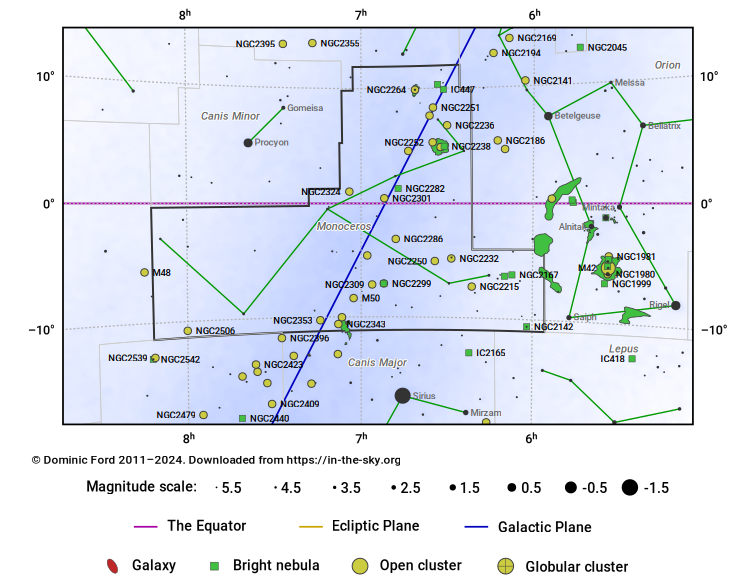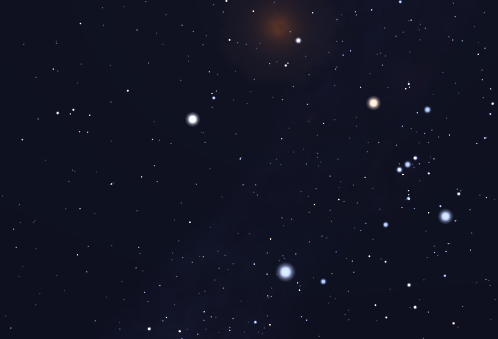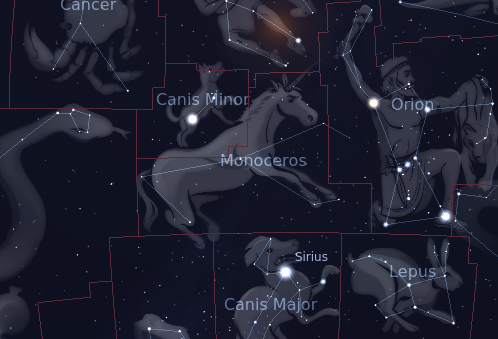The Constellation Monoceros
Monoceros is an equatorial constellation, visible in the evening sky in the months around December, immediately to the east of Orion. It is a large but faint area of sky, whose brightest star has a magnitude of only 3.9.
The name ‘Monoceros’ is Latin for unicorn, and was first assigned to this sky area by Petrus Plancius in 1612, on the same star globe in which he added the constellation Camelopardalis, the giraffe.
Despite its lack of bright stars, Monoceros is easy to find due to its proximity to Orion. The Milky Way passes right through the middle of the constellation, and so it is a rich hunting ground for open star clusters.
1612 (Plancius)
1.2% of the sky
481.6 square degrees
The following constellations neighbor Monoceros: Canis Major, Canis Minor, Gemini, Hydra, Lepus, Orion, Puppis.
Hover the pointer over the name of an object to highlight its position on the starchart to the right, or click to see more information.
| Stars | Open Clusters | Globular Clusters | Galaxies |
| α-Mon (mag 3.9) | NGC 2264 (mag 4.1) | NGC 2494 (mag 14.3) | |
| γ-Mon (mag 4.0) | NGC 2232 (mag 4.2) | NGC 2377 (mag 14.6) | |
| δ-Mon (mag 4.1) | NGC 2244 (mag 4.8) | ||
| ζ-Mon (mag 4.4) | Messier 50 (mag 5.9) | ||
| ε-Mon (mag 4.4) | NGC 2301 (mag 6.0) | ||
| 18-Mon (mag 4.5) | NGC 2343 (mag 6.7) | ||
| 13-Mon (mag 4.5) | NGC 2353 (mag 7.1) | ||
| β-Mon (mag 4.6) | NGC 2335 (mag 7.2) | ||
| S Mon (mag 4.7) | NGC 2251 (mag 7.3) | ||
| V645 Mon (mag 4.7) | NGC 2286 (mag 7.5) | ||
| 17-Mon (mag 4.8) | NGC 2506 (mag 7.6) | ||
| 20-Mon (mag 4.9) | NGC 2252 (mag 7.7) | ||
| NGC2142 (mag 4.9) | NGC 2215 (mag 8.4) | ||
| 27-Mon (mag 4.9) | NGC 2324 (mag 8.4) | ||
| V637 Mon (mag 5.0) | NGC 2236 (mag 8.5) | ||
| 3-Mon (mag 5.0) | NGC 2299 (mag 8.9) | ||
| TYC4797-1881-1 (mag 5.0) | NGC 2250 (mag 8.9) | ||
| 10-Mon (mag 5.0) | NGC 2254 (mag 9.1) | ||
| 2-Mon (mag 5.0) | NGC 2311 (mag 9.6) | ||
| HIP 29417 (mag 5.1) | NGC 2269 (mag 10.0) | ||
| HIP 31278 (mag 5.1) | NGC 2309 (mag 10.5) | ||
| HIP 32558 (mag 5.1) | NGC 2259 (mag 10.8) | ||
| 25-Mon (mag 5.1) | NGC 2262 (mag 11.3) | ||
| 77-Ori (mag 5.2) | NGC 2368 (mag 11.8) | ||
| HIP 32064 (mag 5.2) | NGC 2319 (mag 11.8) | ||
| HIP 31119 (mag 5.2) | NGC 2306 | ||
| HIP 33878 (mag 5.2) | NGC 2312 | ||
| HIP 28744 (mag 5.2) | NGC 2260 | ||
| 7-Mon (mag 5.2) | NGC 2226 | ||
| TYC4797-1882-1 (mag 5.3) | NGC 2338 |




